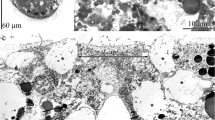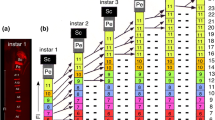Summary
The pore plates of Pimpla are about 40–75 μm long and 5–7 μm wide. Through a central cuticular canal they are in contact with the lumen of the antennae. Under the perforated plate blind-ending tunnels extend in the distal and proximal directions. It is extremely probable, that the pore plates of Hymenoptera are derivatives of basiconical sensilla. The ontogeny of the pore plates was followed back to the beginning of the deposition of the cuticulin layer. Each pore plate ‘anlage’ contains 40–47 sensory cells and 6 enveloping cells. Envelope cell 1 secretes the dendritic sheath, which is fully reduced during ontogeny. The envelope cells 2a and b (trichogen cells) are mirror images of each other, they form the perforated plate and the pore tubules. On both sides of the trichogen cells lie the envelope cells 3a and b (tormogen cells), they also form mirror images of each other. The tormogen cells secrete a cuticular ledge, that surrounds the perforated plate. In the outer distal position lies envelope cell 4, which encircles the pore plate ‘anlage’ in the proximal direction. Envelope cell 4 folds in and retreats from the epithelium surface, thus forming a ‘joint-furrow’ around the pore plate ‘anlage’. The doubling of the trichogen cell is unusual in insects and so far has been observed in basiconic sensilla and pore plates of Hymenoptera only. The doubling of the tormogen cell until now could be established only in basiconic sensilla of Cephus and of Xiphydria (Hymenoptera, Symphyta). In pupae 3–4 days old the trichogen and tormogen cells begin to retreat from the perforated plate. In the imago this outer receptor lymph cavity is nearly completely filled by the branched outer dendritic segments.
Zusammenfassung
Die etwa 40–75 μm langen Porenplatten stehen über einen zentralen Kutikulakanal mit dem Antennenlumen in Verbindung. Unter der porendurchsetzten Sinnesplatte laufen in der Fühlerwand blind endende Tunnel distal- und proximalwärts. Die Porenplatten sind höchstwahrscheinlich Derivate basiconischer Sensillen; ihre Ontogenese wurde bis zur Abscheidung der Cuticulinschollen zurückverfolgt. Jeder Porenplattenanlage sind 40–47 Sinneszellen sowie 6 Hüllzellen zuzuordnen. Hüllzelle 1 scheidet die Dendritenscheide ab, die im Laufe der Ontogenese völlig reduziert wird. Die spiegelbildlich angeordneten Hüllzellen 2a und b (=trichogene Zellen) bilden die Sinnesplatte mit dem Porentubulussystem. Außen schließen die ebenfalls spiegelsymmetrischen Hüllzellen 3a und b an (=tormogene Zellen), die die trichogenen Zellen auf beiden Seiten umfassen. Sie scheiden eine rings um die Sinnesplatte herumlaufende kutikulare Randleiste ab. Die am weitesten außen liegende Hüllzelle 4 umwächst die Sensillenanlage von distal nach proximal. Durch Einfaltung und Zurückweichen der Hüllzelle 4 entsteht rings um die Porenplatte eine „Gelenkfurche“. Die bei Insekten ungewöhnliche Verdoppelung der trichogenen Zelle wurde bisher nur bei basiconischen Sensillen und Porenplatten von Hymenopteren festgestellt, die Verdoppelung der tormogenen Zelle nur bei basiconischen Sensillen von Cephus und Xiphydria (Hymenoptera, Symphyta). Bei etwa 3–4 Tage alten Puppen beginnen sich die trichogenen und tormogenen Zellen von der Sinnesplatte zurückzuziehen. Diesen äußeren Liquorraum füllen bei der Imago die in dünne Äste aufgespaltenen Dendritenaußenglieder weitgehend aus.
Similar content being viewed by others
Abbreviations
- Ä :
-
Dendritenäste
- C :
-
Dendritenaußenglied (=Sinnescilium)
- D :
-
Dendriteninnenglied (=Sinnesfortsatz)
- DS :
-
Dendritenscheide
- E :
-
Epidermiszelle
- Ex :
-
Exuvialraum
- G :
-
Gliazelle (=Sinneszellhüllzelle)
- K :
-
Kutikulakanal (=Porenplattenkanal)
- L :
-
Randleiste
- LA :
-
Randleistenausweitung
- M :
-
Sensillengelenkmembran
- P :
-
Porenplatte
- Pk :
-
Porenkanal
- Po :
-
Pore
- Pt :
-
Porentubulus
- R :
-
Porenplattenrand
- S :
-
Spalt
- SP :
-
Sinnesplatte
- Sz :
-
Sinneszelle
- T :
-
Tunnelkutikula
- V :
-
Verstärkungsgerüst der Sinnesplatte
- W :
-
Randwulst
- 1–4 :
-
Hüllzellen 1–4
Literatur
Altner H (1977) Insektensensillen: Bau und Funktionsprinzipien. Verh Dtsch Zool Ges 70:139–153
Altner H, Prillinger L (1980) Ultrastructure of invertebrate chemo-, thermo-, and hygroreceptors and its functional significance. Int Rev Cytol 67:69–139
Barlin MR, Vinson SB (1981) Multiporous plate sensilla in antennae of the Chalcidoidea (Hymenoptera). Int J Insect Morphol Embryol 10:29–42
Barlin MR, Vinson SB, Piper GL (1981) Ultrastructure of the antennal sensilla of the cock-roach-egg parasitoid, Tetrastichus hagenowii (Hymenoptera: Eulophidae). J Morphol 168:97–108
Becker R (1981) Die Ontogenie der Porenplatten auf der Antenne der Honigbiene (Apis mellifera L.) (Hymenoptera, Apidae). Zulassungsarbeit wiss. Prüfung Lehramt Gymn, Karlsruhe
Beha G (1978) Der Feinbau der Sinnesorgane auf dem Fühlerendglied von Pimpla turionellae (Hymenoptera, Ichneumonidae). Zulassungsarbeit wiss. Prüfung Lehramt Gymn, Karlsruhe
Borden JH, Chong L, Rose A (1978a) Morphology of the elongate placoid sensillum on the antennae of Itoplectis conquisitor. Ann Entomol Soc Amer 71:223–227
Borden JH, Rose A, Chorney RJ (1978b) Morphology of the elongate sensillum placodeum on the antennae of Aphidius smithi (Hymenoptera: Aphidiidae). Can J Zool 56:519–525
Ernst KD (1969) Die Feinstruktur von Riechsensillen auf der Antenne des Aaskäfers Necrophorus (Coleoptera). Z Zellforsch Mikrosk Anat 94:72–102
Ernst KD (1972) Die Ontogenie der basiconischen Riechsensillen auf der Antenne von Necrophorus (Coleoptera). Z Zellforsch Mikrosk Anat 129:217–236
Ernst A (1979) Die Ultrastruktur der Sinneshaare auf den Antennen von Geophilus longicornis LEACH (Myriapoda, Chilopoda) II. Die Sensilla basiconica. Zool Jahrb Abt Anat Ontog Tiere 102:510–532
Falk R, Bleiser-Avivi N, Atidia J (1976) Labellar taste organs of Drosophila melanogaster. J Morphol 150:327–342
Fischer T (1981) Die Feinstruktur der olfaktorischen Sensillen (Sensilla basiconica) auf den Antennen von Xiphydria camelus (Hymenoptera, Siricoidea). Zulassungsarbeit wiss. Prüfung Lehramt Gymn, Karlsruhe
Gnatzy W (1978) Development of the filiform hairs on the cerci of Gryllus bimaculatus Deg. (Saltatoria, Gryllidae). Cell Tissue Res 187:1–24
Gnatzy W, Schmidt K (1972) Die Feinstruktur der Sinneshaare auf den Cerci von Gryllus bimaculatus Deg. (Saltatoria, Gryllidae) IV. Die Häutung der kurzen Borstenhaare. Z Zellforsch 126:223–239
Guse GW (1980) Development of antennal sensilla during moulting in Neomysis integer (Leach) (Crustacea, Mysidacea). Protoplasma 105:53–67
Hallberg E (1979) The fine structure of the antennal sensilla of the pine saw fly Neodiprion sertifer (Insecta: Hymenoptera). Protoplasma 101:111–126
Harris DJ (1977) Hair regeneration during moulting in the spider Ciniflo similis (Araneae, Dictynidae). Zoomorphologie 88:37–63
Haupt J (1982) Hair regeneration in a solpugid chemotactile sensillum during moulting (Arachnida: Solifugae). Roux's Arch Developm Biol 191:137–142
Hofacker H (1980) Sensillen auf den Fühlern bei Panorpa communis L. (Mecoptera) und Chrysopa carnea Steph. (Planipennia). Zulassungsarbeit wiss. Prüfung Lehramt Gymn, Karlsruhe
Keil T (1978) Die Makrochaeten auf dem Thorax von Calliphora vicina Robineau-Desvoidy (Calliphoridae, Diptera). Feinstruktur und Morphogenese eines epidermalen Insekten-Mechanoreceptors. Zoomorphologie 90:151–180
Lacher V, Schneider D (1963) Elektrophysiologischer Nachweis der Riechfunktion von Porenplatten (Sensilla placodea) auf den Antennen der Drohne und Arbeitsbiene (Apis mellifica L.). Z vergl Physiol 47:274–278
Martini M (1981) Bau und Entwicklung der Sensilla placodea auf den Fühlern von Gymnomerus laevipes (Shuckard) (Vespoidea, Eumenidae). Zulassungsarbeit wiss. Prüfung Lehramt Gymn, Karlsruhe
Meyer NF (1925) Zur Biologie und Morphologie von Pimpla examinator Fabr. (Hymenoptera, Ichneumonidae). Z angew Entomol 11:202–212
Rath O vom (1888) Über die Hautsinnesorgane der Insekten. Z Wiss Zool 46:437–453
Richerson JV, Borden JH (1972) Host finding by heat perception in Coeloides brunneri (Hymenoptera: Braconidae). Can Entomol 104:1877–1881
Richerson JV, Borden JH, Hollingdale J (1972) Morphology of a unique sensillum placodeum on the antennae of Coeloides brunneri (Hymenoptera: Braconidae). Can J Zool 50:909–913
Rieder N, Spaniol H (1980) Die Rezeptoren an den ersten Antennen von Leptestheria dahalacensis Rüppel (Crustacea, Conchostraca). Zoomorphologie 95:169–179
Schaffelhofer A (1979) Die Feinstruktur der olfaktorischen Sensillen (Sensilla basiconica) auf den Antennen von Cephus pygmaeus (Hymenoptera, Cephidae). Zulassungsarbeit wiss. Prüfung Lehramt Gymn, Karlsruhe
Schaller D (1978) Antennal sensory system of Periplaneta americana L. Distribution and frequency of morphologic types of sensilla and their sex-specific changes during postembryonic development. Cell Tissue Res 191:121–139
Schenk O (1903) Die antennalen Hautsinnesorgane einiger Lepidopteren und Hymenopteren mit besonderer Berücksichtigung der sexuellen Unterschiede. Zool Jahrb Abt Anat Ontog Tiere 17:573–618
Schmidt K (1973) Vergleichende morphologische Untersuchungen an Mechanorezeptoren der Insekten. Verh Dtsch Zool Ges 66:15–25
Schmidt K, Gnatzy W (1971) Die Feinstruktur der Sinneshaare auf den Cerci von Gryllus bimaculatus Deg. (Saltatoria, Gryllidae) II. Die Häutung der Faden-und Keulenhaare. Z Zellforsch Mikrosk Anat 122:210–226
Schmidt K, Kuhbandner B (im Druck) Ontogeny of the sensilla placodea on the antennae of Aulacus striatus JURINE (Hymenoptera: Aulacidae). Int J Insect Morphol Embryol
Slifer EH, Sekhon SS (1961) Fine structure of the sense organs on the antennal flagellum of the honey bee, Apis mellifera LINNAEUS. J Morphol 109:351–381
Steinbrecht RA, Müller B (1976) Fine structure of the antennal receptors of the bed bug, Cimex lectularius L. Tissue Cell 8:615–636
Such J (1978) Embryologie ultrastructurale de l'ommatidie chez le phasme Carausius morosus BR. (Phasmida: Lonchodidae): Morphogenese et cytodifferenciation. Int J Insect Morphol Embryol 7:165–183
Vogel R (1923) Zur Kenntnis des feineren Baues der Geruchsorgane der Wespen und Bienen. Z Wiss Zool 120:281–324
Wacker F (1925) Beiträge zur Kenntnis der antennalen Sinnesorgane der Hymenopteren. Z Morphol Ökol Tiere 4:739–812
Walther J (1981) Die Morphologie und Feinstruktur der Sinnesorgane auf den Antennengeißeln der Männchen, Weibchen und Arbeiterinnen der Roten Waldameise Formica rufa LINNÉ 1785 mit einem Vergleich der antennalen Sensillenmuster weiterer Formicoidea (Hymenoptera). Diss Fachber Biologie F U Berlin
Yokohari F (1981) The sensillum capitulum, an antennal hygro- and thermoreceptive sensillum of the cockroach, Periplaneta americana L. Cell Tissue Res 216:525–543
Author information
Authors and Affiliations
Rights and permissions
About this article
Cite this article
Stepper, J., Becker, C. & Schmidt, K. Feinbau und Ontogenese der Porenplatten auf den Antennen von Pimpla turionellae (Hymenoptera, Ichneumonidae). Zoomorphology 102, 11–32 (1983). https://doi.org/10.1007/BF00310730
Received:
Issue Date:
DOI: https://doi.org/10.1007/BF00310730




